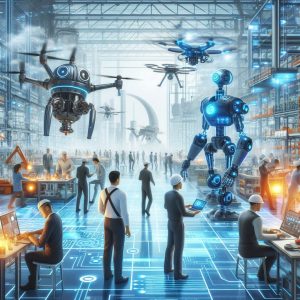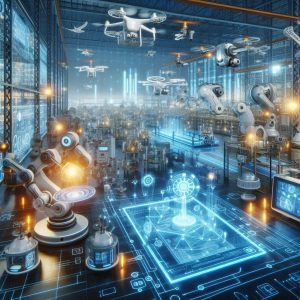The manufacturing landscape in the United States is on the verge of a revolution, transitioning from Industry 4.0 to Industry 5.0. As businesses seek ways to enhance productivity, improve sustainability, and prioritize human-machine collaboration, Industry 5.0 is rapidly gaining traction. According to recent market research, the U.S. Industry 5.0 market is poised to experience significant growth, driven by advancements in robotics, artificial intelligence (AI), and the increasing need for a human-centered approach to automation.
Industry 5.0 is an emerging paradigm that focuses on the collaboration between humans and machines in the manufacturing process. Unlike Industry 4.0, which emphasized automation and machine-to-machine communication, Industry 5.0 seeks to harmonize human capabilities with advanced technologies like robotics, AI, and IoT (Internet of Things). The goal is to enhance human creativity and problem-solving while leveraging machines for precision, speed, and repetitive tasks.
Industry 5.0 is about finding the perfect balance between human ingenuity and the efficiency of automation. It emphasizes the unique strengths of both humans and machines, enabling workers to oversee more complex tasks while allowing robots and AI to handle the monotonous and physically demanding parts of the process.

Key Drivers of Industry 5.0 Growth in the U.S.
Several factors are contributing to the rapid rise of Industry 5.0 in the United States. These include the need for increased manufacturing flexibility, enhanced workforce capabilities, and a growing demand for customized products.
1. Human-Machine Collaboration for Enhanced Efficiency
The driving force behind Industry 5.0 is the shift from fully automated processes to environments where humans and machines collaborate in real-time. This collaboration is made possible by the increasing sophistication of robots, AI, and other technologies that can work alongside human workers, enhancing their decision-making and allowing them to focus on more creative tasks.
For instance, in advanced manufacturing facilities, robots are increasingly taking over dangerous, repetitive, or precision-based tasks, while human workers focus on oversight, quality control, and problem-solving. This reduces workplace injuries, improves productivity, and leads to more personalized manufacturing processes that align with customer demands.
2. Technological Advancements in Robotics and AI
Technological advancements are making it possible for robots to be more adaptable and capable of working alongside humans. The use of AI-powered machines in manufacturing allows for real-time decision-making and learning, while collaborative robots (cobots) are designed to safely work alongside human workers without the need for safety barriers.
The advent of advanced sensors, machine learning, and predictive analytics has significantly improved the performance of robots, enabling them to be more responsive to changes in the production environment. These advancements also enable manufacturers to implement more efficient supply chain management and demand forecasting, ultimately leading to reduced downtime and increased operational efficiency.
3. Sustainability and Customization Demands
Industry 5.0’s human-centric approach is also helping manufacturers meet growing consumer demand for more sustainable and customizable products. With greater flexibility in production systems, companies can provide more personalized products tailored to individual customer preferences. This is particularly beneficial in industries like automotive, electronics, and consumer goods, where customization is becoming increasingly important.
Furthermore, the integration of sustainable practices is at the core of Industry 5.0. Smart technologies are being deployed to reduce energy consumption, minimize waste, and optimize production processes. Manufacturers are increasingly using AI and data analytics to ensure that resources are used efficiently, contributing to a greener, more sustainable industry.
Download PDF Brochure @
https://www.marketsandmarkets.com/pdfdownloadNew.asp?id=35376359
4. Skilled Workforce and Enhanced Training
As automation continues to advance, the demand for skilled labor is shifting. While Industry 4.0 required workers to adapt to new technologies, Industry 5.0 focuses on enhancing human capabilities. Workers are required to possess not just technical skills but also creativity, problem-solving abilities, and emotional intelligence, making them more valuable in the workplace.
To support this, companies are investing in comprehensive training and upskilling programs to equip workers with the skills needed to thrive in an Industry 5.0 environment. These programs focus on developing workers’ ability to work effectively with AI and robots while fostering their creative and strategic thinking.

Industry 5.0 is being implemented across various sectors in the U.S., including automotive, electronics, aerospace, and consumer goods. For example, automotive manufacturers are using cobots to assist workers in assembling vehicles, improving the speed and quality of production while reducing the risk of injuries. Similarly, the electronics industry is incorporating AI-powered machines to handle delicate assembly processes, ensuring higher precision and faster production cycles.
Moreover, the healthcare sector is embracing Industry 5.0 concepts to create personalized medical devices and treatments. Robots and AI are being used to assist in the development of custom prosthetics, while human workers provide the creative input and oversight needed for design.
The Future Outlook for Industry 5.0 in the U.S.
As the U.S. embraces Industry 5.0, manufacturers are increasingly recognizing its potential to transform how goods are produced. By fostering human-machine collaboration, U.S. industries are becoming more adaptive, innovative, and efficient. Industry 5.0 promises to unlock new levels of productivity and creativity, all while enhancing worker safety and promoting sustainability.
The U.S. is poised to lead this new wave of industrial transformation, thanks to its strong technology infrastructure, skilled workforce, and innovative mindset. As Industry 5.0 continues to evolve, businesses that leverage human-centric automation will gain a competitive edge, creating new opportunities for growth and success in the global market.
The future of manufacturing in the U.S. lies in the fusion of human creativity and machine efficiency. Industry 5.0 is ushering in an era of enhanced collaboration, sustainability, and innovation. As U.S. manufacturers adopt this human-centric model, they will not only meet the demands of today’s consumers but also pave the way for a more sustainable and efficient future.
With increasing investments in AI, robotics, and worker training, Industry 5.0 is set to revolutionize U.S. manufacturing, creating a dynamic and adaptive ecosystem that prioritizes human expertise while harnessing the power of cutting-edge technologies.
